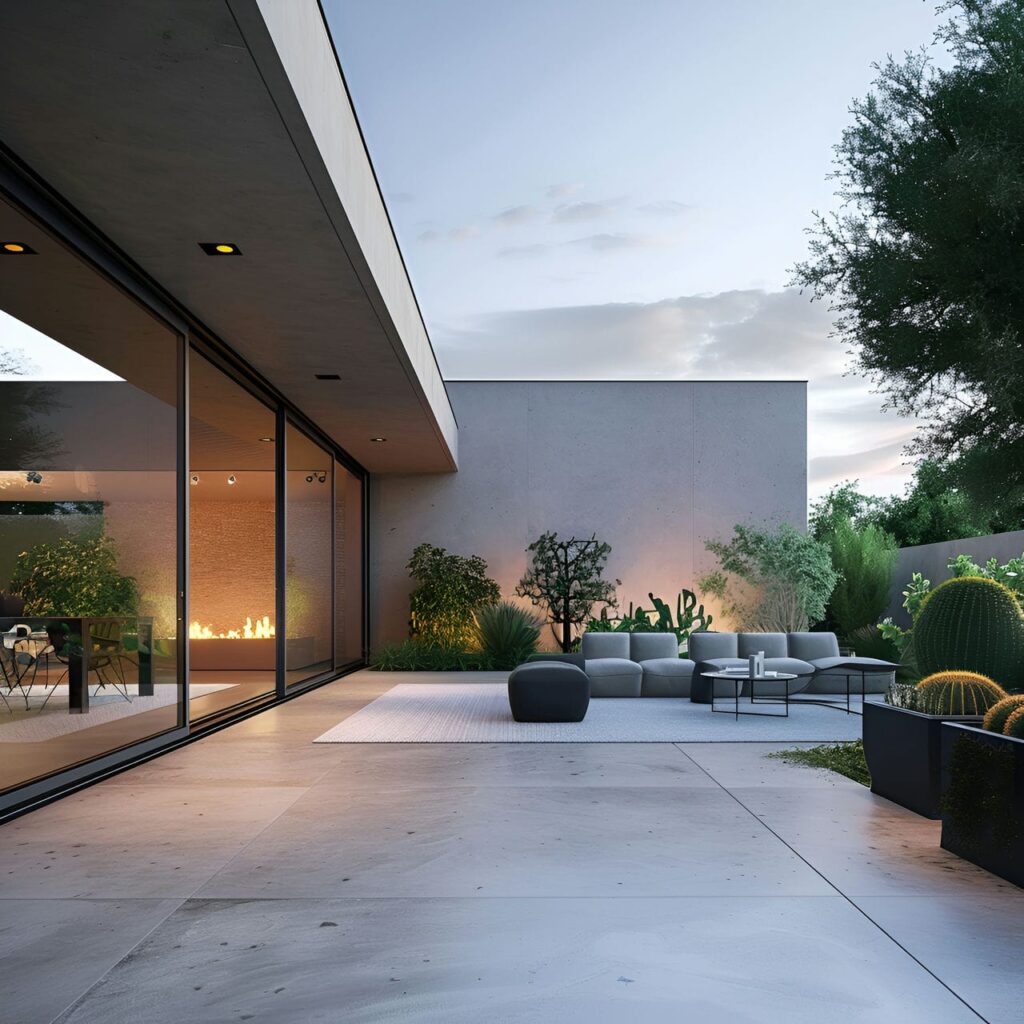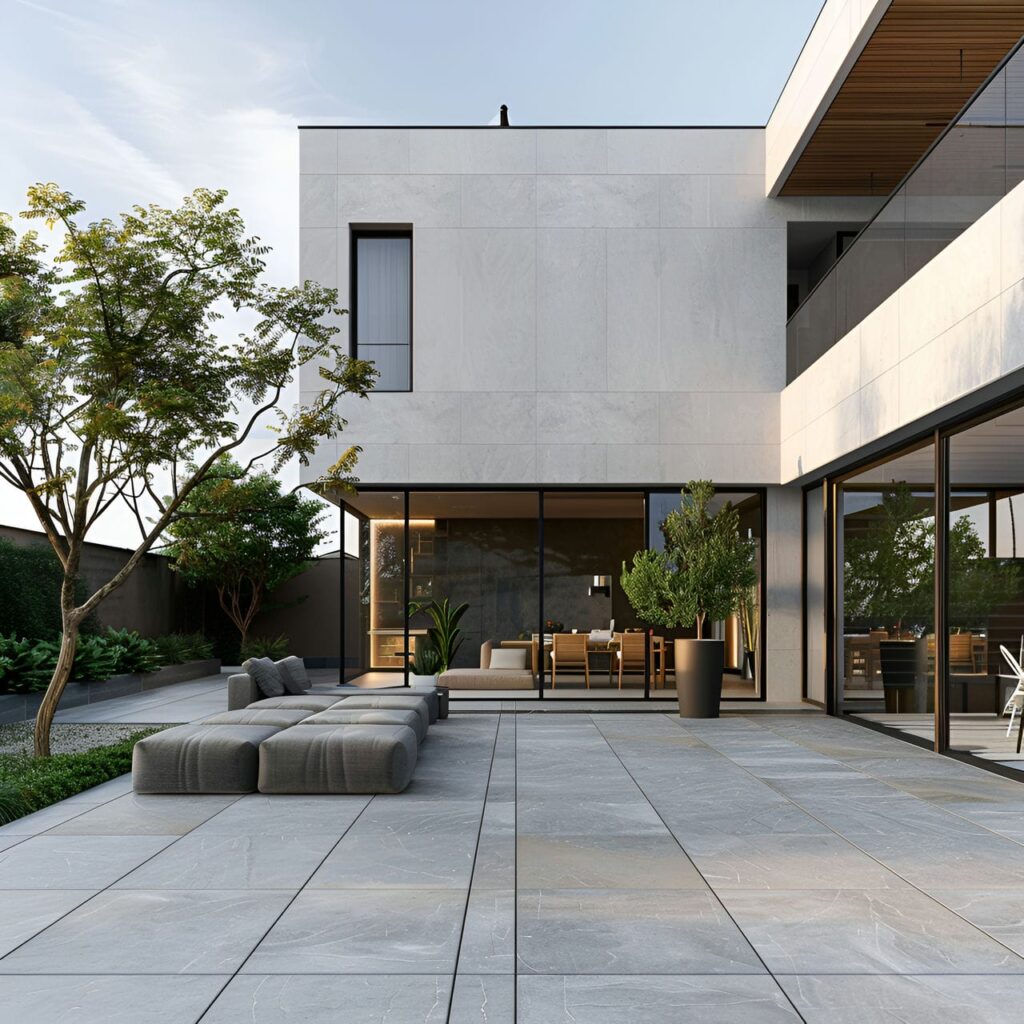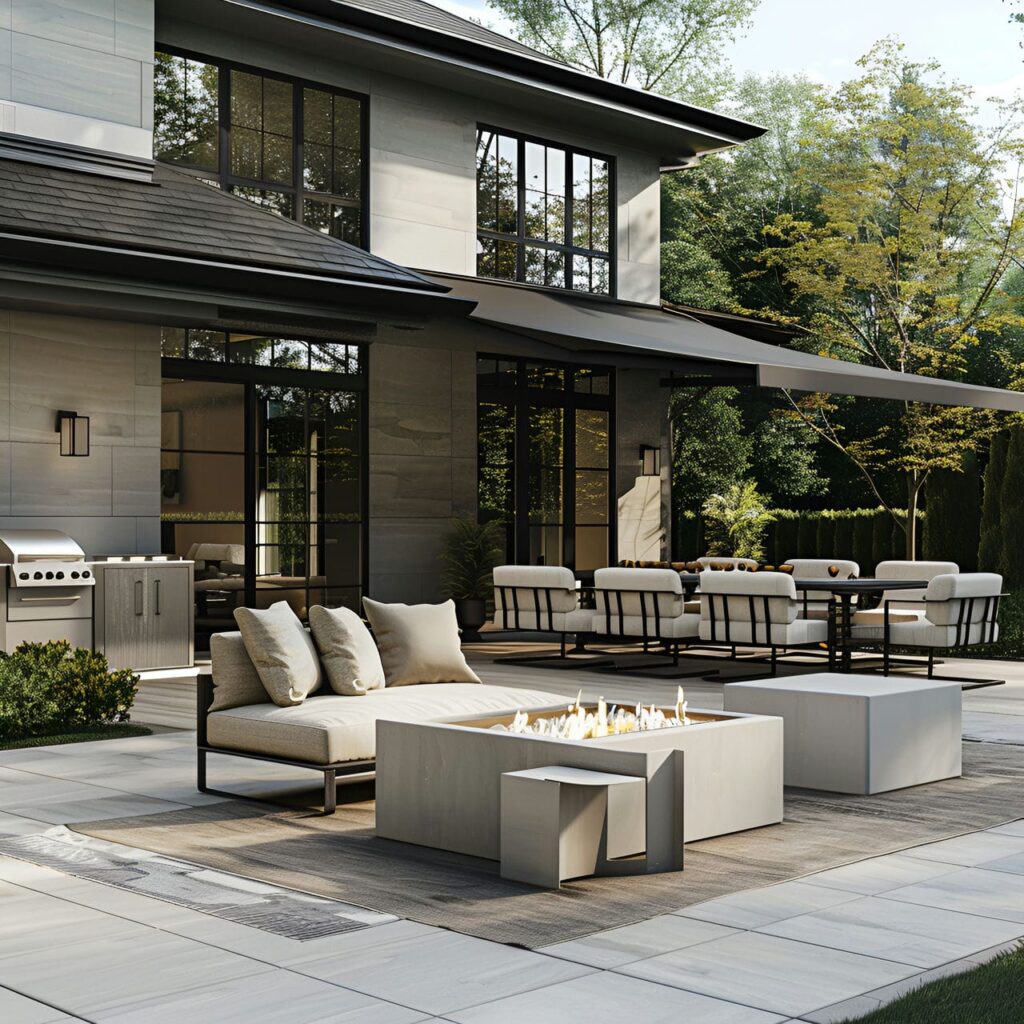A typical residential patio ranges from approximately 130 square feet (12 square meters) to 170 square feet (16 square meters), suitable for essential furniture like a bistro dining set and lounge chairs. Patios serve as outdoor living spaces for relaxation and entertainment, providing an affordable extension of indoor areas with a higher return on investment. They enable indoor and outdoor living integration and offer opportunities for leisure activities. Common patio furniture includes outdoor dining sets, lounge chairs, conversation sets, side tables, umbrellas, storage benches, and fire pits. Functional patios feature multipurpose spaces with durable construction, lighting, weather protection, and accessories. Energy efficiency is achieved through insulation, water conservation, efficient heating and cooling systems, renewable energy integration, and natural lighting and shading. Renovating a patio costs between $3,000 (€2,700, £2,300) and $10,000 (€9,000, £7,600). They can help in layout optimization, material durability, lighting creation, integration with the home, sustainability, and regulatory compliance. Architect fees for patio renovation range from $1,500 (€1,350, £1,150) to $5,000 (€4,500, £3,800), depending on the project’s complexity. Redecorating a patio takes 2 to 6 weeks, depending on the scale, size, material availability, and unforeseen challenges. Homeowners need help with weather, budget constraints, material selection, privacy concerns, and coordinating with contractors. Hiring an architect can alleviate some challenges, providing professional expertise and project management.
What is the typical size of a patio?
A typical residential patio ranges from 130 square feet (12 square meters) to 170 square feet (16 square meters). This allows fitting essential furniture like a bistro dining set, lounge chairs, and a freestanding fire pit or grill conveniently. The standard 8-foot (2.4 meter) ceiling height of the home’s rear exterior applies. The 130-170 square foot (12-16 square meter) area provides outdoor living space for 2-4 people. The average home patio measures between 170 square feet (16 square meters) and 300 square feet (28 square meters) to accommodate more furnishings better. The average ceiling height remains exterior standard at 8 feet (2.4 meters). The typical patio incorporates comfortable conversation sets, outdoor cabinets, and an 8-person dining table without congestion across the tile, wood, or deck floors to entertain family and friends.
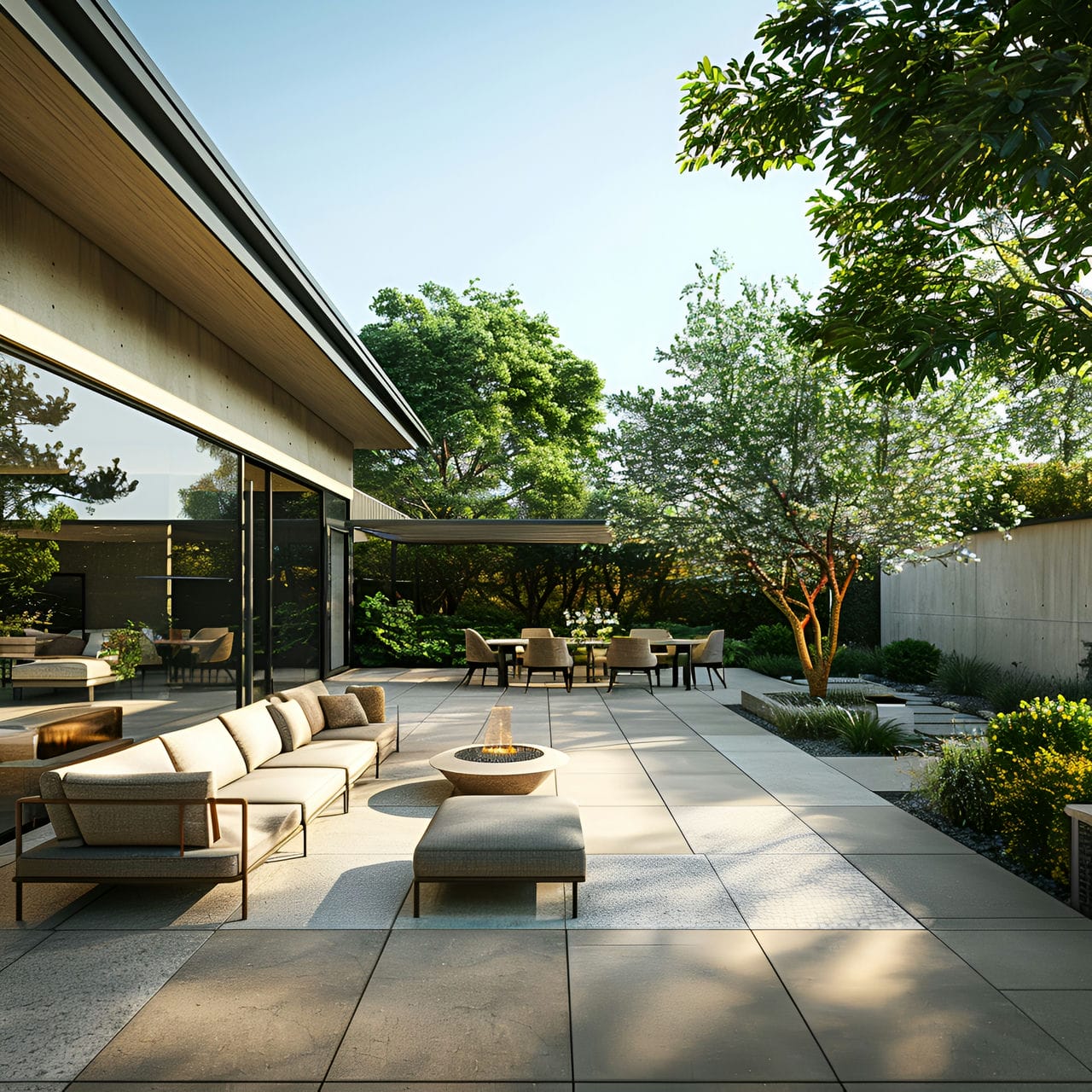
Grand patios in luxury estates open to expanses exceeding 645 square feet (60 square meters) minimally. Spacious layouts incorporate multiple conversation areas, ample 12+ person dining with buffet/serving carts, outdoor kitchens, bar areas, caldron fire features, weatherproof televisions, and specialty landscaping. Architectural ceiling structures allow the incorporation of retractable canopy shade coverings and aperture roofs to control sunlight/climate across the patios.
What is the use and purpose of a patio?
The purpose of a patio is to provide relaxation, leisure activities, and integration of indoor and outdoor areas. Firstly, a patio is an outdoor living space for relaxation, dining, or entertainment. It provides extra room to enjoy fresh air while still having protection from the elements under an overhang, awning, or pergola. Secondly, a patio adds flexible outdoor space to a home at a relatively affordable cost. Constructing a complete sunroom addition can be expensive, but patio paving and roofing have a higher return on investment in increased home value. Thirdly, patios allow better integration of indoor and outdoor areas for a seamless living space. Matching ground materials and finishes connects the interior flooring visually to the exterior patio. Lastly, patios boost opportunities for leisure activities, from arts and crafts to games. The durable surface and proximity to the home make patios conducive for more hobbies to be pursued outdoors.
What is the typical shape of a patio?
The typical shape of a patio is either a rectangular or square footprint. Rectangular plans situate the longest walls spanning from approximately 50 square feet (4 meters) to 75 square feet (7 meters) facing the best views, with narrow ends ranging from approximately 30 square feet (2.5 meters) to 50 square feet (4 meters). Centered stairways connect the ground-level room to the interior living areas. Identical square dimensions ranging from approximately 50 square feet (4 meters) to 75 square feet (7 meters) concentrate essentials equally accessible from a central walkway point. Grid-shaped patios break up the space with fences or built-in planters defining distinct vignettes like dining, lounging, and grilling pockets within the larger footprint. For contemporary homes allowing indoor spaces to flow outside via sliding wall systems or retractable screens, patios efficiently adopt versatile fluid shapes using the nearest exterior flat land.
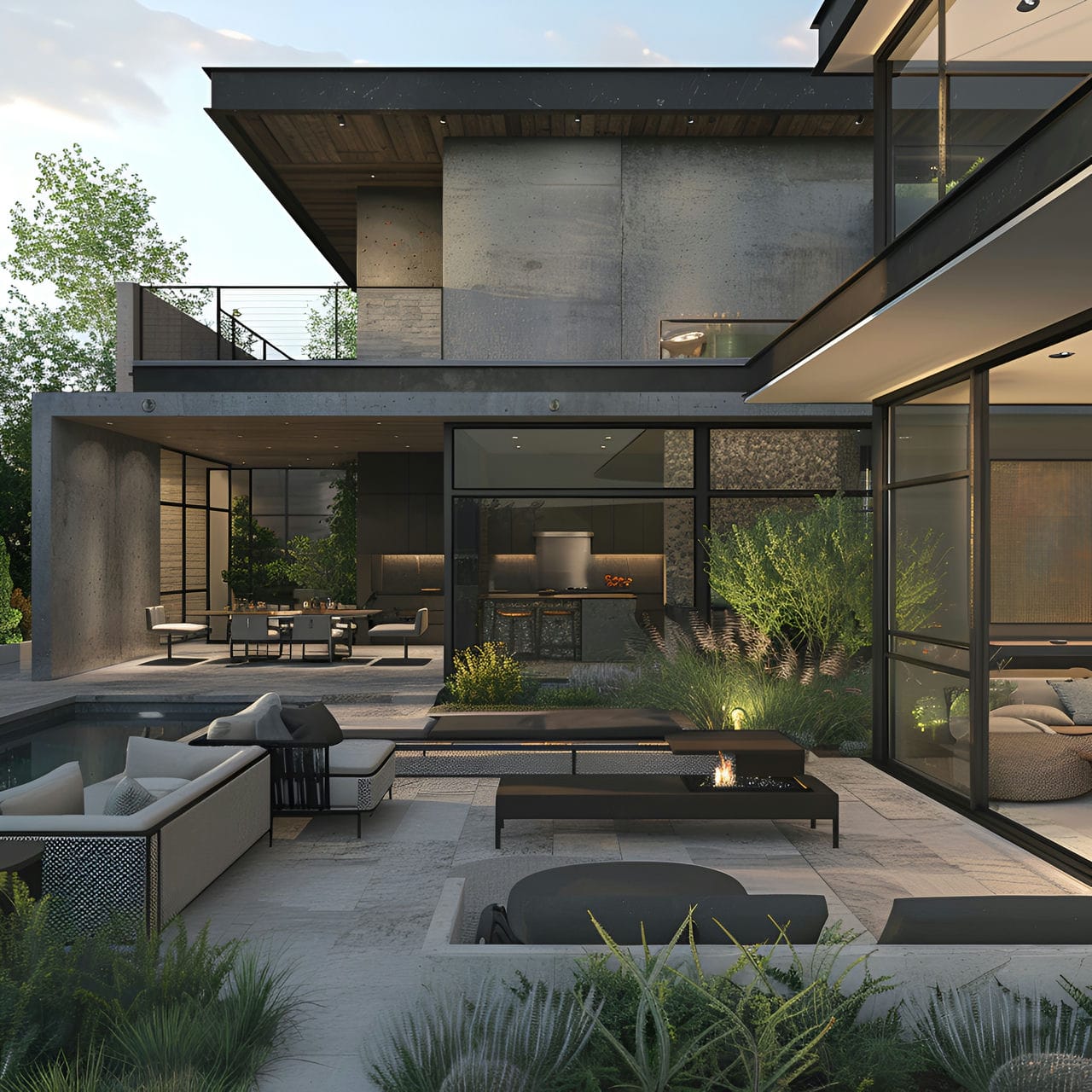
What furniture commonly equips a patio?
Listed below are the types of furniture commonly equip a patio:
- Outdoor dining sets: Outdoor dining sets on a patio are central for hosting meals and gatherings. This furniture includes a table and matching chairs crafted from wrought iron, aluminum, or weather-resistant wood. Patio dining sets come in various sizes, catering to intimate family dinners or more significant social events. They often feature umbrellas or canopies for shade, enhancing dining comfort.
- Lounge chairs: Lounge chairs on a patio offer a comfortable spot for relaxation and sunbathing. This furniture is made from durable materials such as all-weather wicker, teak, or metal. These chairs include cushions for added comfort. Patio lounge chairs are designed for outdoor leisure, perfect for poolside areas or sunny spots.
- Conversation sets: Conversation sets on a patio provide a cozy area for socializing and relaxation. These furniture sets include a small sofa or loveseat, chairs, and a coffee table. Constructed from weather-resistant materials like wicker, aluminum, or wood, patio conversation sets are designed for outdoor use. Cushions and pillows enhance comfort and add a decorative touch.
- Side tables: Side tables on a patio are essential for functionality and convenience. Made from metal, glass, or treated wood, they withstand outdoor elements. Patio side tables offer a handy surface for drinks, snacks, or decorative items, complementing the primary seating furniture.
- Umbrellas: Umbrellas on a patio provide essential shade, making outdoor spaces more comfortable and usable. These furniture come in various sizes and styles, from center-pole to cantilever designs. Patio umbrellas are made with UV-resistant fabrics and sturdy frames to withstand sun and wind.
- Storage benches: Storage benches on a patio combine seating with practical storage. Constructed from durable, weather-resistant materials, this furniture provides a space to store cushions, gardening tools, or entertainment supplies.
- Fire pits: Fire pits on a patio serve as a focal point and provide warmth for outdoor gatherings. Available in various styles and fuel types, including wood-burning, gas, and propane, this furniture caters to different preferences. They are designed with safety in mind, often including protective screens or barriers.
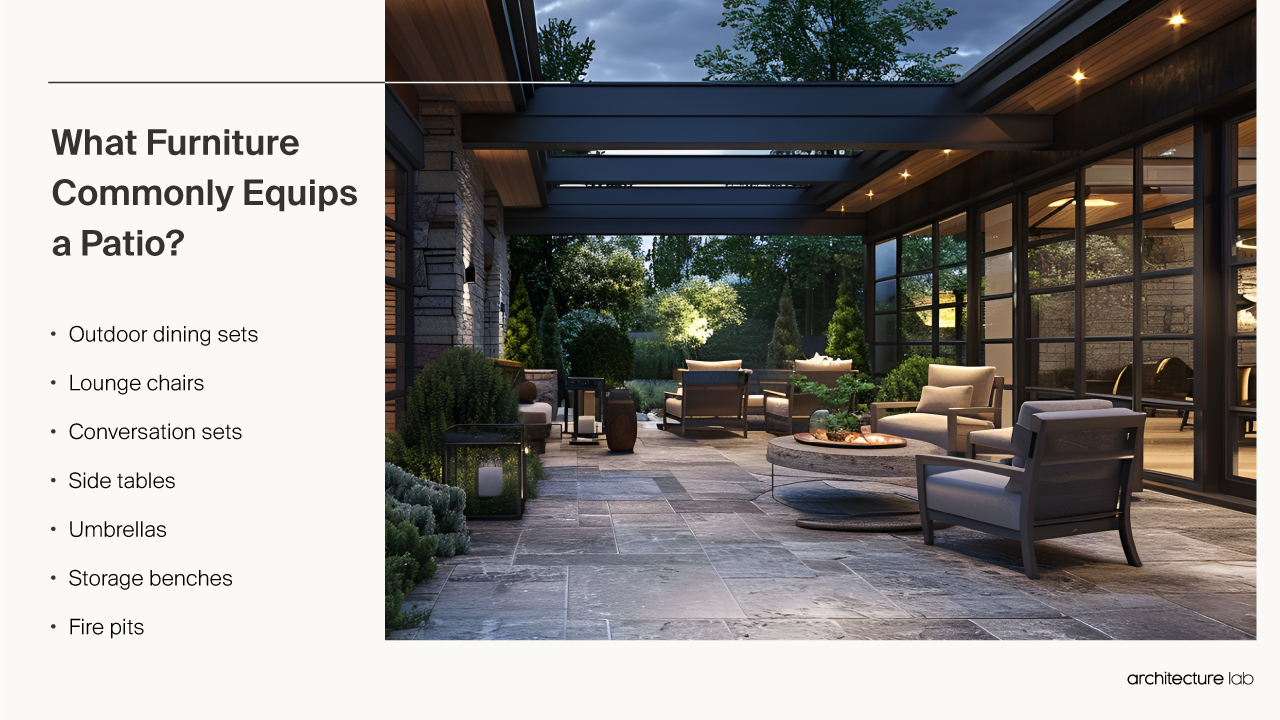
What is the normal ceiling height of a patio?
The normal ceiling height of a patio is 8 feet (2.4 meters), where gutters mount averaging 9 feet (2.7 meters) off the floor level. The infinite vertical clearance allows flexibility to incorporate tall landscaping or structural features like pergolas up to 10 feet (3 meters) without infringing on the required headroom for the space below. The perfect covered ceiling balances provide a sheltered refuge from the weather while retaining an open, breezy patio environment. Some two-story abutting rear patios below balcony decks establish upper barriers averaging 9 feet (2.7 meters) off the lower patio floor.
What colors are patios usually painted?
Listed below are the paint colors usually used in patios:
- Green: Green colors reflect on the patio in the outdoor nature. Shades like sage, olive, and mint are popular, harmonizing with garden foliage. Green creates a seamless transition between indoor and outdoor spaces.
- Blue: Blue colors in patios evoke the sky and water elements. Common choices include sky blue, teal, and navy. These colors provide a calm, relaxing ambiance for outdoor relaxation spaces. Blue is often paired with natural materials like wood or stone, enhancing the patio’s connection to nature.
- Beige: Beige colors are chosen for patios due to their neutrality. Variants range from light sand to warm taupe. Beige offers a subtle backdrop, complementing outdoor views.
- White: White colors in patios create a bright, open feel. White is famous for its clean look and versatility, complementing various design elements effortlessly. It can make small patios appear larger.
- Gray: Gray colors in patios offer a contemporary, sophisticated look. Shades vary from light silver to charcoal. Gray is a neutral, versatile base, compatible with various accent colors.
- Yellow: Yellow colors in patios bring brightness and cheer. Shades like lemon or sunflower create a sunny, welcoming ambiance. Yellow is used as an accent color, complementing neutral tones.
- Terracotta: Terracotta colors are popular in patios for their warm, earthy feel. Terracotta pairs well with natural elements like wood or greenery. It’s often used in Mediterranean or southwestern-style patios, enhancing the outdoor aesthetic.
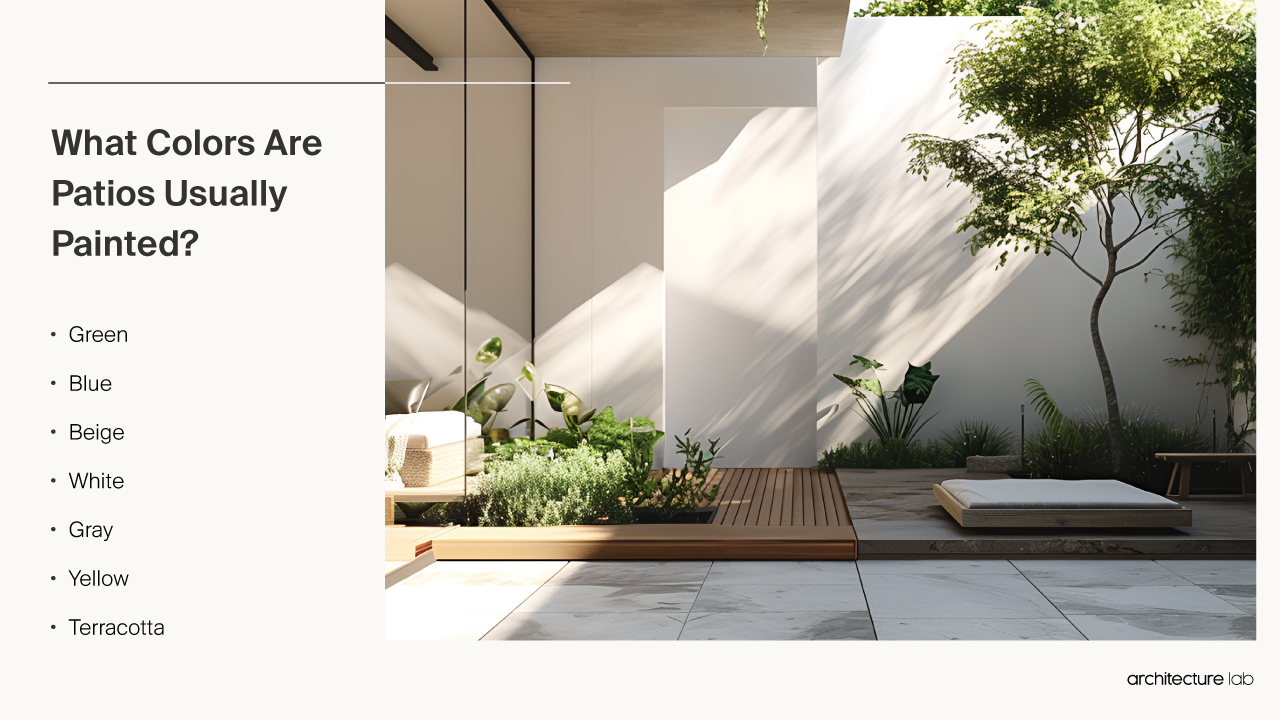
What makes the patio functional?
The patio is functional by multipurpose spaces, durable construction, lighting, weather protection, decor, and accessories. Firstly, the primary function of a patio is to provide outdoor living space for relaxation, dining, or entertainment. Well-designed patios extend the usable area of the home into the backyard or garden. Secondly, functional patio design considers layout, traffic flow, and multiple seating areas to accommodate different activities. Separate spaces for a dining set, sofa and chairs, fire pit, and other features prevent a crowded feel. Hardscaping elements like paths, steps, and low walls guide movement smoothly around the patio. Thirdly, lighting and accessories tailor the patio for nighttime gatherings or all-day enjoyment. Weather-resistant rugs, throw pillows, curtains, and artwork carry interior style outside. Built-in or portable heating lamps, fans, and misters extend seasons of use in many climates. Lastly, covering part or all of the patio protects from sun exposure and light rain. Retractable awnings, umbrellas, pergolas, or pavilion roofs maintain views while offering shade and shelter at need. Enclosed screens keep out insects for greater comfort.
How is energy efficiency achieved in a patio?
Energy efficiency in a greenhouse patio can be achieved through insulation and glazing, water conservation, heating and cooling systems, renewable energy integration, and natural lighting and shading. Firstly, insulation and glazing are critical for maintaining a stable temperature within the patio. Triple glazing for patio doors can reduce heat loss, providing enhanced insulation and decreasing the amount of energy required for heating or cooling. Secondly, water conservation is essential in a greenhouse patio. Techniques such as drip irrigation, collecting rainwater, and covering the soil with mulch can help reduce water usage and evaporation. Thirdly, heating and cooling systems must be chosen carefully to optimize energy use. Radiant heating systems that heat objects rather than the air can be more efficient for heating. For cooling, evaporative coolers can provide immediate relief in outdoor areas. Using energy curtains can help retain heat in the winter and maintain a constant internal temperature in the summer. Fourthly, integrating renewable energy sources such as solar thermal panels can reduce reliance on fossil fuels and lower energy costs. Passive solar heat can supplement heating, especially when combined with electric heat. Lastly, maximizing natural lighting and shading can significantly impact energy efficiency. Strategic vegetation placement can provide shade and reduce the need for artificial cooling. Energy-efficient LED lighting systems can be used for supplemental lighting, reducing electricity usage.
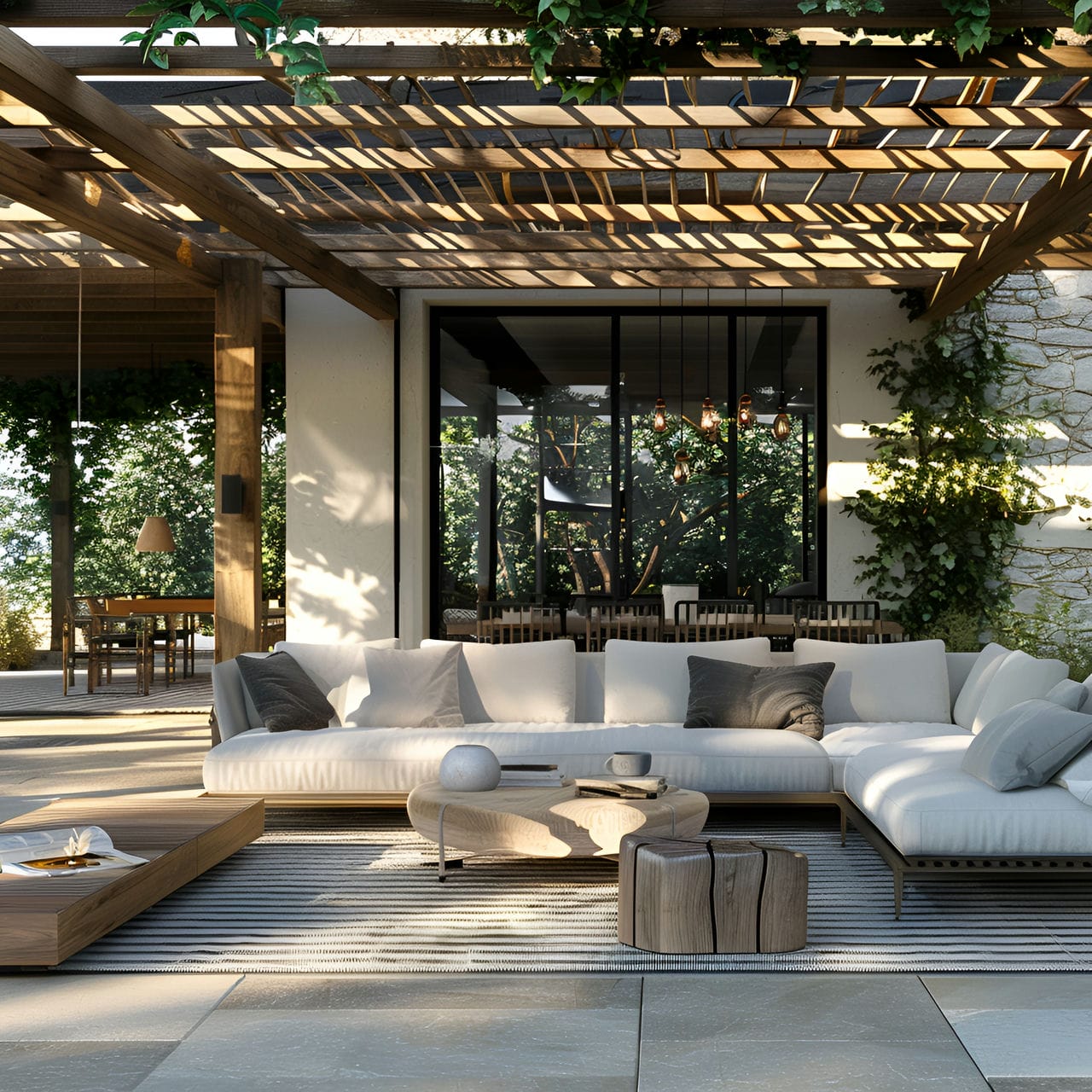
How much does it typically cost to renovate a patio?
The average cost to renovate a patio space ranging from 175 square feet (16 square meters) to 300 square feet (28 square meters) falls between $3,000 (€2,700, £2,300) to $10,000 (€9,000, £7,600). Cosmetic changes like new stone pavers or concrete staining averages closer to $3,000 (€2,700, £2,300). Structural alterations like removing walls, expanding square footage, and pouring new raised foundation slabs for hot tubs or outdoor kitchenettes drive prices toward $10,000 (€9,000, £7,600). Comfort heating options range from $2,000 (€1,800, £1,500) to $4,000 (€3,600, £3,000) depending on system complexity. Permanent overhead structures with lighting, like pergola rafters or retractable canopy screens, increase budgets to $15,000 (€13,500, £11,400). Typical patio upgrades range from $3,000 (€2,700, £2,300) to $7,500 (€6,750, £5,700). Significant square footage additions for entertaining or incorporating high-end accessories like fireplaces or water features raise bottom lines past $15,000 (€13,500, £11,400) and beyond if integrating elaborate masonry detailing.
What factors affect the patio renovation?
Listed below are the factors that affect the patio renovation:
- Size and layout: The size and design influence a patio renovation. Larger patios offer more space for various features, while smaller ones require efficient use of space. Renovation plans must consider the existing layout, assessing the need for expansion or restructuring.
- Flooring materials: Choosing flooring materials is crucial in a patio renovation. Options like concrete, pavers, wood, or tiles vary in durability, maintenance, and appeal. The material selected must withstand local weather conditions and align with the desired look and feel.
- Covering and shade options: Covering and shade options are vital in patio renovations. Structures like pergolas, awnings, or umbrellas protect from the elements and enhance comfort. The type of covering chosen affects the patio’s usability in different weather conditions.
- Landscaping and garden features: Landscaping and garden features are key factors in patio renovations. Incorporating plants, trees, flower beds, or water features like fountains or ponds can enhance the patio’s aesthetics and create a natural ambiance.
- Furniture and decor: Furniture and decor are essential in defining a patio’s style and function. Choices range from dining sets and lounge chairs to outdoor rugs and decorative lighting. The selection of furniture and decor needs to balance aesthetics, comfort, and weather resistance.
- Privacy and security measures: Privacy and security are essential in patio renovations. Features like fences, privacy screens, or security systems enhance the sense of seclusion and safety. These measures are necessary in urban or densely populated areas.
- Budget and financial constraints: The budget and financial constraints are pivotal in shaping a patio renovation. A larger budget allows for more extensive changes and premium materials, while a limited budget may necessitate prioritizing key improvements.
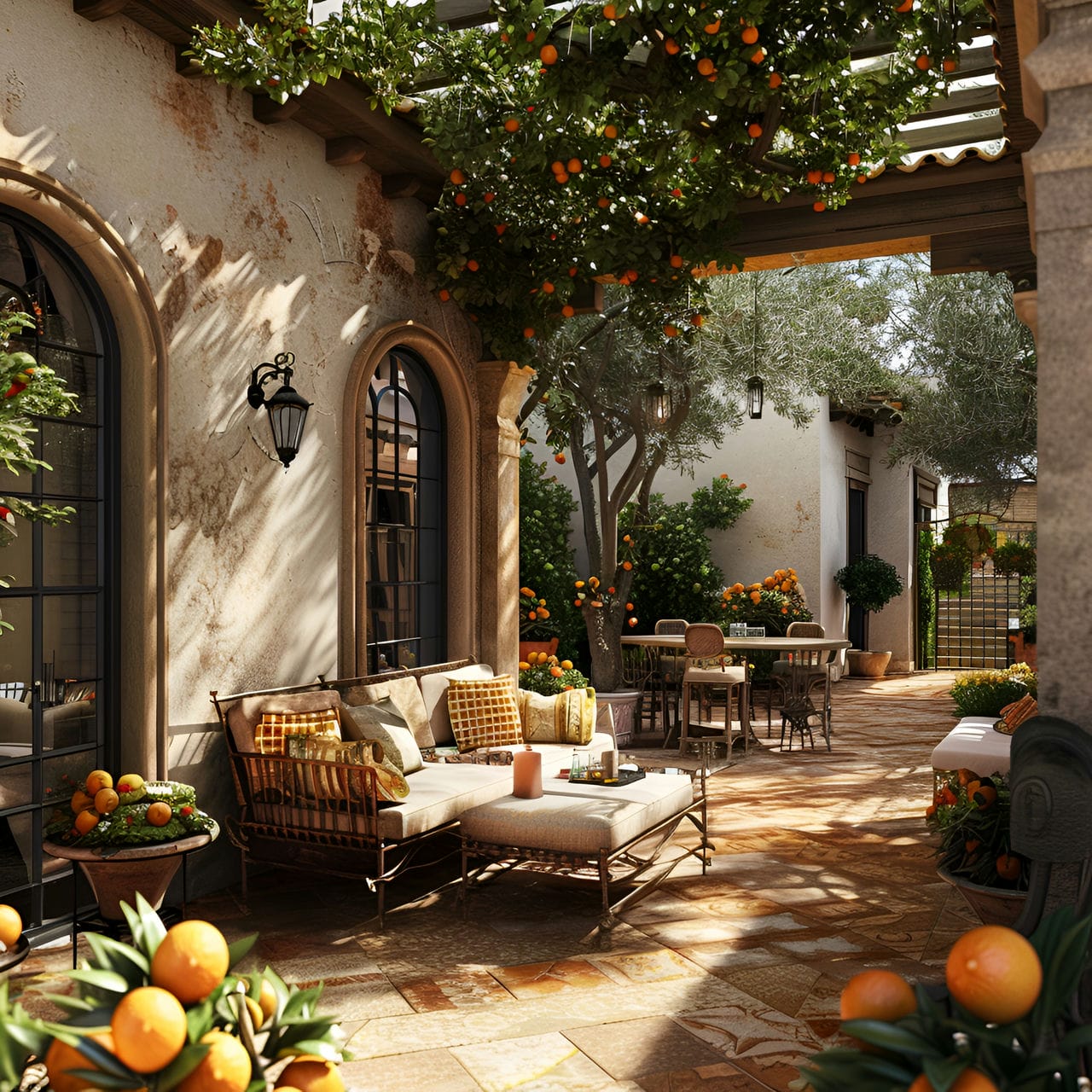
Is an architect required to renovate a patio?
No, an architect is not required to renovate a patio, but it is highly advised to hire one. They can provide innovative solutions for layout, material selection, and integration with the existing landscape and home architecture, enhancing the aesthetic and value of the property. An architect’s expertise in spatial planning ensures efficient use of the available space, potentially transforming a patio into a more versatile and inviting area. Architects are well-versed in local building codes and regulations, ensuring that the renovation complies with legal requirements and avoids potential pitfalls. They can also manage the project, coordinating with contractors and suppliers, which can save time and reduce stress for the homeowner.
How can an architect help you upgrade a patio?
Listed below are the ways that an architect can help an owner upgrade a patio:
- Design and layout optimization: An architect can optimize the design and layout of a patio, enhancing its functionality and aesthetic appeal. They assess the existing space to develop a layout that maximizes usability, flow, and visual appeal. This process includes placing seating areas, dining spaces, and landscaping elements.
- Material selection and durability: Appropriate materials for a patio are crucial, and an architect can provide expert guidance. They recommend durable, weather-resistant materials suitable for the local climate and the homeowner’s style preferences. This selection includes flooring, furniture, and structural materials for pergolas or canopies.
- Lighting and creation: An architect can create the right ambiance through a patio design. They design a lighting plan that highlights architectural features, provides functionality, and creates a warm atmosphere.
- Integration with the home: An architect ensures integration of the patio with the rest of the home. This integration involves considering the house’s architectural style and providing the patio that complements it.
- Sustainability and eco-friendliness: Architects can incorporate sustainability and eco-friendliness into patio designs. This might involve using recycled or eco-friendly materials, designing for natural shade to reduce energy usage, or integrating water-saving landscaping features.
- Permits and regulatory compliance: Navigating permits and regulatory compliance is a complex aspect of patio upgrades, and an architect can manage this process. They understand local zoning laws, building codes, and permit requirements, ensuring the renovation complies with all regulations.
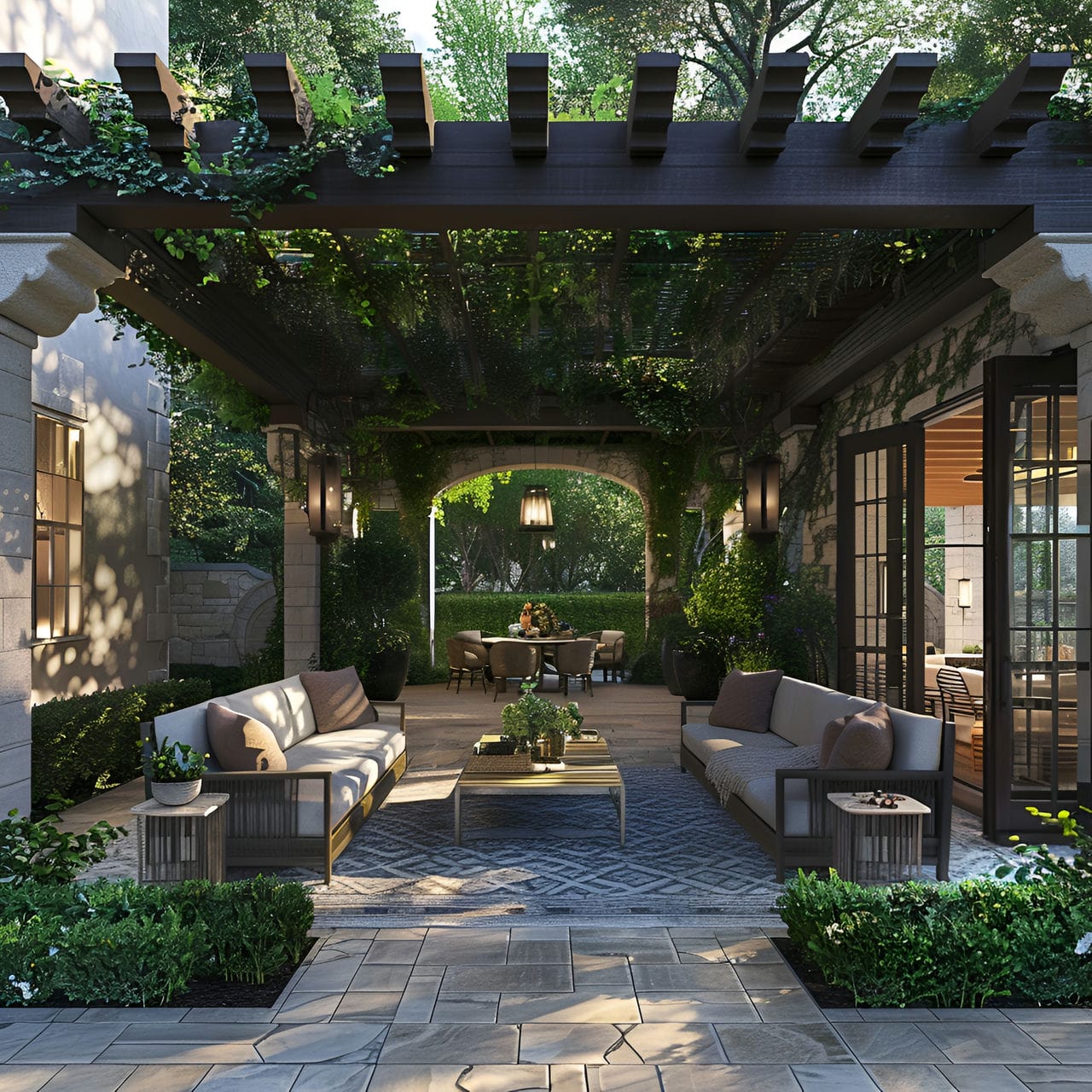
How much does it cost to hire an architect to renovate a patio?
The average cost to hire an architect to design a residential patio renovation ranges from $1,500 (€1,350, £1,150) to $5,000 (€4,500, £3,800). Most architects charge $100 (€90, £75) to $175 (€155, £135) per hour. Enhancing a 175 square foot (16 square meters) patio with simplified repainted concrete staining and refreshed landscaping takes 10-15 hours and costs approximately $1,500 (€1,350, £1,150). Incorporating layout adjustments to a 300 square foot (28 square meters) outdoor area, like widened stepping stones, privacy fencing, or built-in bench seating, requires 20-30 hours, averaging around $3,000 (€2,700, £2,300). Top-tier landscape designers collaborate on fully integrated architecture using collapsible glass walls, cantilevered open-air spas amidst tiered garden water features, electronic privacy screens, and designer stonework masonry for high-end contemporary patio entertainment escapades charging $5,000 (€4,500, £3,800) or more given substantial engineering coordination spanning 30-50 hours. Typical patio update concepts run $1,500 (€1,350, £1,150) to $3,000 (€2,700, £2,300), while extensive layout redesigns allowing signature luxury living room extensions match customization investments between $3,000 (€2,700, £2,300) to $5,000+ (€4,500+, £3,800+).
Is it worth it to hire an architect to upgrade a patio?
Yes, hiring an architect for a patio upgrade is worth it. They have the skill to address challenges such as spatial limitations, material selection, and integration with the natural environment. Architects are adept in designing outdoor spaces that enhance the usability of the patio, whether for dining, relaxation, or entertainment, adding significant value to the outdoor living experience. Their ability to coordinate with contractors and manage the project can also streamline the process, making it more efficient and less stressful. It represents an additional upfront cost. The long-term benefits of functionality, compliance, and design excellence often make hiring an architect for a patio upgrade worthwhile.
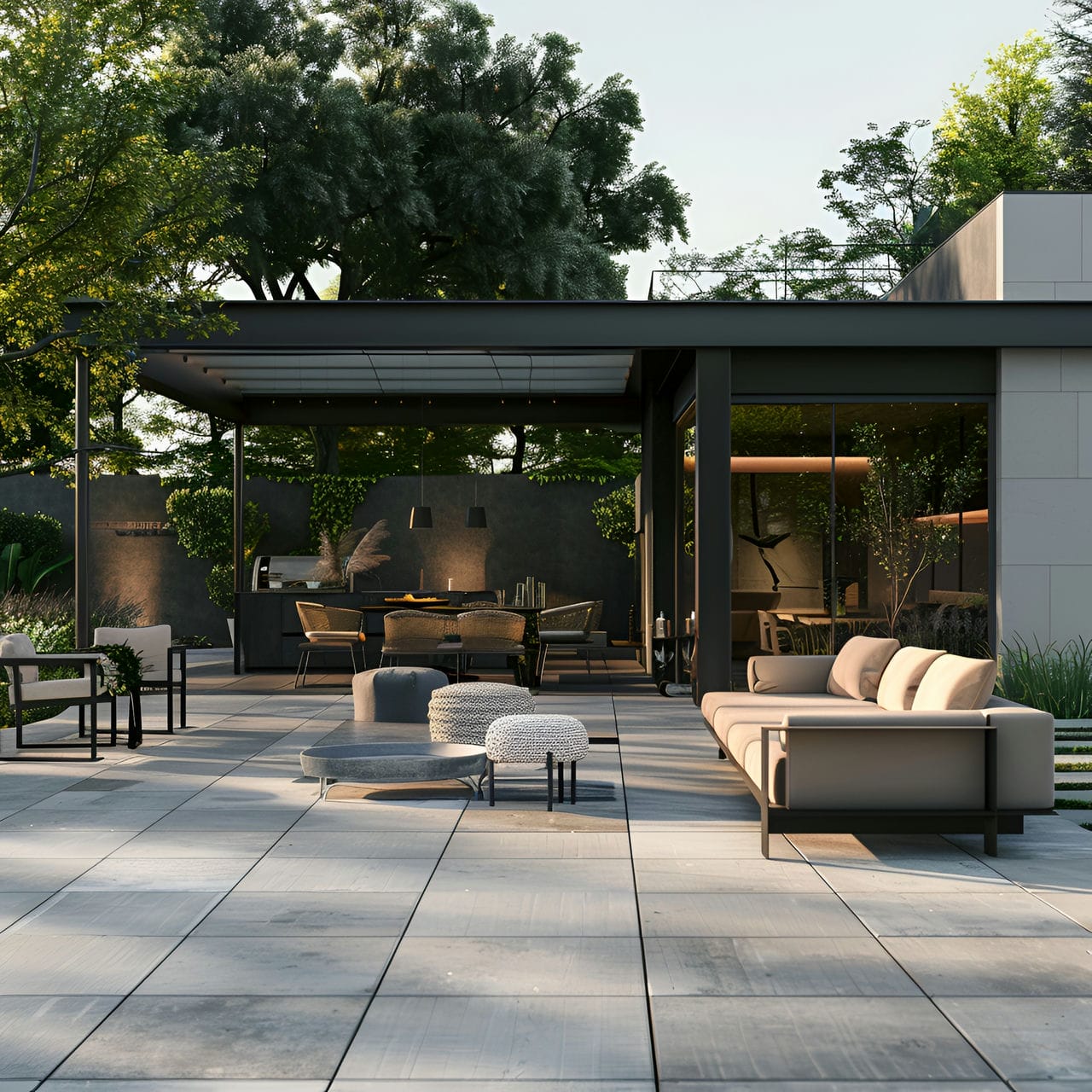
How long is needed to redecorate a patio?
Redecorating a patio requires 2 to 6 weeks. Firstly, the scale of the redecoration project is a major determinant. Minor aesthetic updates like adding new furniture or plants might be completed quickly, while extensive changes, such as installing new flooring or building outdoor structures, might be completed promptly. Secondly, the size of the patio influences the timeline. Larger patios require more time for redecoration due to the greater area to cover and the potential complexity of the design. Thirdly, the availability and delivery of materials and furniture play a significant role. Custom or special-order items can have longer lead times, which might extend the project duration. Lastly, unforeseen challenges or complications can open the project duration. This could include unexpected structural issues, delays in supply chains, or weather disruptions. While straightforward patio redecorations can be relatively quick, more involved projects with multiple elements and dependencies can extend up to six weeks or more.
What are the struggles of the homeowner to redecorate a patio?
Listed below are the struggles of the homeowner to redecorate a patio:
- Weather considerations: Dealing with weather considerations is a primary struggle when redecorating a patio. If not properly considered, the patio could suffer damage or require frequent maintenance, leading to additional costs and effort in the long run.
- Budget constraints: Managing budget constraints is a struggle during patio redecoration. Homeowners must allocate funds for various elements, from furniture to landscaping, while preparing for unforeseen expenses. Staying within budget means making tough choices on materials, features, and the extent of the renovation.
- Material selection: Selecting suitable materials for durability and maintenance is a significant concern for homeowners redecorating a patio. The vast array of options available can be overwhelming, and making the wrong choice can lead to increased maintenance or replacement costs.
- Privacy concerns: Addressing privacy concerns is a significant issue for many homeowners during patio redecoration. Creating a private and secluded outdoor space can be challenging in densely populated areas.
- Choosing and coordinating with contractors: Homeowners often need help choosing and coordinating with contractors for patio redecoration. Miscommunication, delays, or subpar work can lead to a frustrating renovation experience and unsatisfactory results.
